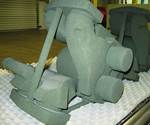Pros and Cons of Making Foundry Patterns Via 3D Printing
A new method of pattern making brings various advantages, not the least of which is expanded design freedom. But 3D printing of patterns is not without trade-offs.
In casting, a mold produces the form of the cast part, while a pattern is used to make the form of this mold. Pattern making is therefore the heart of casting.
Danko Arlington is a company that recently turned to 3D printing—specifically, fused deposition modeling—as a potentially more efficient way to make castings. In a report on the company’s website, company president John Danko discusses the pros and cons of making patterns through additive manufacturing. According to Mr. Danko, those pros and cos include:
Pro
- Design freedom
- Incorporation of intricate features
- Reduced labor
- Speed
- Customers’ high interest in 3D printing
Con
- Equipment cost
- Material cost
- Risk of pattern distortion during printing
- Difficulty repairing or modifying a pattern made through 3D printing
- Potential distortion of 3D printed patterns by hot foundry sand
Read more in Danko Arlington’s report.
Yet another option, instead of 3D printing a pattern, is to 3D print the mold itself directly in sand.
Related Content
-
Is 3D Printing Competing with Casting? AM Radio #27B
On this episode of AM Radio, we discuss two examples of companies that are shortening supply chains by using 3D printing instead of casting.
-
3D Printing Method for Complex Metal-Plastic Composite Structures
Researchers from Japan and Singapore have developed a new 3D printing technique to create precise patterns on the external and internal surfaces of 3D plastic structures.
-
AM 101: What Is Hot Isostatic Pressing (HIP)? (Includes Video)
Hot isostatic pressing has long been used for metal castings, but is now being applied as a valuable method for closing porosity in metal 3D printed parts.

.jpg;width=70;height=70;mode=crop)













